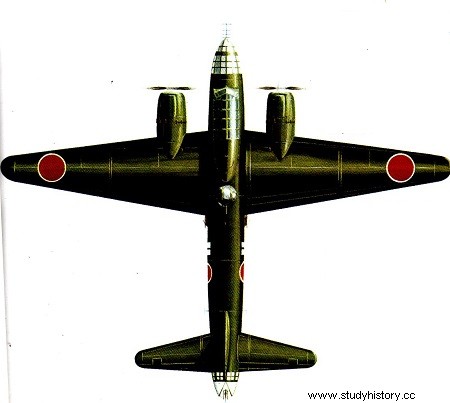
The best and most famous assault bomber used by the Imperial Japanese Navy Air Force during World War II was the Mitsubishi G4M operating from land bases in the Eastern theaters of operations. Although the load carried was reduced and the protection of the crew and the tanks dramatically insufficient, its performance and especially its autonomy were spectacular.
The design of the G4M began in 1937 when the navy issued a tender for a naval assault bomber to replace Mitsubishi's 03M which had just entered service in . units engaged against China. The new type was to be powered by two 1,000 horsepower engines, have a range of 4,800 km and a speed of around 400 km/h. The Mitsubishi team under the direction of Kiro Honjo quickly realized that the required performance could not be achieved with such reduced power and concentrated their studies on a very pure monoplane equipped with two 1,500 horsepower Mitsubishi Kasei radial engines. One of the main shortcomings of the G3M was its lack of defensive armament, which was solved in the G4M by the mounting of five 7.7mm machine guns and one 20mm cannon. Despite the considerable volume of fuel required by the autonomy conferred on the aircraft, the designers made the decision not to provide shielding for the tanks and the crew in order to save weight.

The prototype which flew for the first time in October 1939 quickly proved to be up to the specifications requested, if not above. The type was put into production almost immediately. but as a Mitsubishi G6M1 escort fighter and not in the form of the planned bomber. This decision was motivated by the losses suffered in China by the G3M, and the G4M was modified accordingly to become a fighter. The forward and tail guns were retained, the dorsal armament removed, the side guns replaced by a 20 mm gun and a ventral gondola fitted with two identical guns took the place of the bomb bay.
The production of the G4M 1 or Navy Assault Bomber Type 1 Model 11 finally started in 1940, and the first entries into service took place in April 1941. The G4M1 carried out deep raids inside Chinese territory where the absence hunters increased their effectiveness accordingly. The initial operations during the Second World War also paid off for the G4Ms:among these, these aircraft took an important part in the destruction of the battleship Prince of Wales and the battlecruiser Repulse, as well as in the conquest of the Philippines. The fighting on objectives located in New Guinea was the occasion of heavy losses caused by the deployment of a more effective enemy fighter. To remedy this state of affairs, Mitsubishi produced the model 12 (manufacturer's reference G4M1 1 unchanged), with more powerful engines, rudimentary tank protection and extinguisher systems. In return, the range was reduced by 320 km.
Later modifications led to a change of designation. It was then the type G4M2 or Model 22 equipped with Kasei 21 engines of 1,800 horsepower with injection of a water-methanol mixture, better profiling, improved armament, increased fuel capacity and panels. bomb bay. This new model went into production in July 1943. Types 22 A and 22 B corresponded to armament improvements. Although this device was about to become obsolete, the delay in its replacement led to new developments. This resulted in the type G4M2a or Model 24. Better engines, with lower consumption, were mounted and various designations appeared, corresponding to variants of armament. Later versions had a maritime search radar installed in the nose. A smaller but very famous version of the Model 24 was the G4M2e Model 24J tasked with carrying the Yokosuka MXY7 Okha flying kamikaze bomb. Most of the 24J aircraft were conversions of the 24B and 24C bombers. By October 1944, the G4M2 had replaced all the G4M1, henceforth relegated to less important missions. However, combat losses were very heavy for both types, and a new version was developed. shutters, armor for the crew, a redesigned tail turret and a dihedral depth plane. Production started in October 1944, on a small scale, and the G4M type thus ended its military career. This aircraft had achieved success when the enemy defense had shown limited activity, but the losses had been very heavy as soon as the Allied fighters had become more effective. The last war mission of the G4M was to transport the Japanese plenipotentiaries.
The total production of G4M and G6M reached 2,146 aircraft.
Type bombing, transport and suicide-weapon-dropping aircraft; crew :7 men
Motors 2 Mitsubishi MK4T Kasei 25 with 14 air-cooled radial cylinders each giving 1,825 hp at take-off and 1,680 hp at 2,100 m
Defensive armament :2 Type 92 7.7 mm steerable machine guns fed from . 582 rounds per weapon in the nose, 1 Type 99 Model 2 steerable 20 mm gun fed with 270 rounds in the dorsal turret, 2 Type 99 Model 2 steerable guns of 20 mm with 270 rounds each in the middle position and 1 Type 99 Model steerable gun 2 to 270 shots in rear turret
offensive :1,000 kg of bombs maximum or 1 torpedo of 800 kg
Maximum speed 440 km/h at 4,600 m
Cruising speed 315 km/h at 4,000 m
Climbing speed 8,000 m in 30 min 24 s
Practical ceiling 8,950 m
Range 6,000 km
Weight 8,160 kg empty; 12,500 kg loaded
Wingspan 25 m
Length 20 m
Height 6 m
Wing area 78.13 m2
(The performances and weights indicated are
also valid for the G4M2 Model 22)
